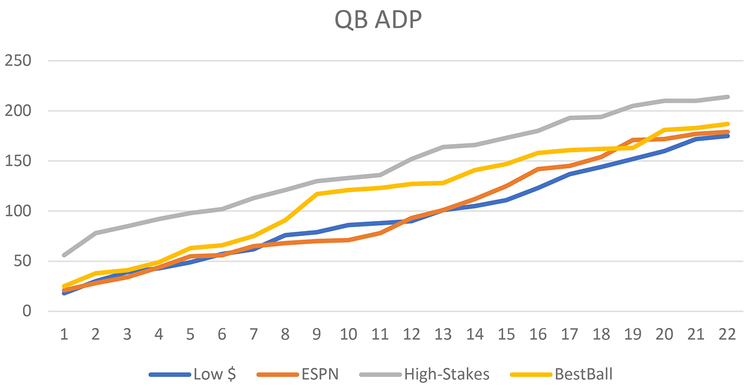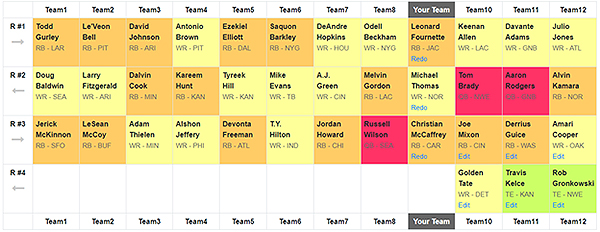14 Helpful Steps to Winning Fantasy Football Draft Strategies
By Emil KadlecUndated: 8/26/2022


Be ready for your draft, regular season and DFS!
Full Season Premium coverage. (32nd Season!)
$24 plus a 15% discount by using the code: "Diehards."
Bob Harris & Emil Kadlec
Any questions call Emil (505-293-0509)
ORDER NOW!
1. Plan Your Rounds - All Of Them!
An important part of your draft strategy is to plan out who you are targeting in each round. As you compile your sleepers and create your Favorites List, you should be including where you expect to draft these players. ADP is a great asset in planning a draft. An added benefit of planning your rounds is realizing the limitations that may come up. As you start laying these players down you'll see conflicts in rounds where you're trying to fit two picks in. This allows you to adjust your strategy and determine the best path to winning your draft. Most drafts are serpentine-the person who picks last in the first round will pick first in the second round, then the process repeats. Assuming you know your draft position, you can see which rounds you'll be waiting a while to make a pick. This allows you to reconsider the round for each player, given that they may not be there when you pick next. You can also place multiple players in a given round. Things are not always going to go the way you plan them and it is good to have options, not only at the same skill position, but across all positions.2. Roster Goals
Another important factor in understanding your draft strategy is roster goals. You have your starting lineup requirements and limits for your team as well as a total number of players rostered. With these two things, you should create a target number of players at each position. Below is an example.2 QBs
5 RBs
6 WRs
1 TE
1 PK
1 DEF
With this roster goal you can go back to your Plan Your Rounds chart and adjust as necessary. You'll start to see the possible conflicts as your draft progresses and be able to fill the roster as you desire. This draft preparation strategy can really save you as your draft progresses.
Additionally, as you are drafting players, you should keep track of how many you have taken at each position. When you get to the later rounds you may realize you over-selected at one skill position and now one of your late-round players you really wanted will not fit on your team.
3. Determining Players You Want to Target and When
Which players should you target in your draft? There are a large number of players you may want but only 16 of them can end up on your roster in a 16-round draft. Player analysis along with factors like average draft position (ADP) will give you a list of players that you desire for your draft. Following through our draft strategy will give you concepts to help create your target list. ADP helps you realize some players are just too expensive for your tastes. You will also find players that we call "Value Players" who you believe will have a good year and have lower ADP's.Remember, you're building a roster that has limitations. Look at, for example, quarterbacks. Most leagues have one starting quarterback and these leagues have typically 10 to 12 managers. The quarterback position has some uniqueness in the fact that over 12 quarterbacks are typically solid starters. Hence, the "Draft a Quarterback Late" theory is very attractive. To get a great roster, you need to rely on a certain number of sleepers, or as we call them, value players. You can't take everybody in the first round and you want to maximize each skill position to have solid players. With these guidelines, you need to find some value players that you believe have the ceiling of a top-five or top-10 fantasy performance at their skill position.
This is a very key piece of information. As you prepare for your draft and follow these draft strategies, you need to determine your value players and trust in your decisions. Don't worry about what your opponents think or how they're going to laugh when you take a certain player "too early". You can't win a fantasy league by taking zero risks.
Some of your sleepers will even turn out to be busts. You can't get them all right. The point is you need to get a couple right to succeed at the draft. If you're sheepish and don't try to think out of the box you could end up with an average team that doesn't threaten the league at all.
Another example of this strategy of positional value comes at the tight end position. Over the last decade, there are about three tight ends that stand out each year. If you wanted to acquire one of these players you had to draft them early. This year, you may decide that it is worth taking one of them within the first three rounds. However, let's say you conclude that Noah Fant will be a top-five tight end and you can likely draft Fant in the eighth-round based on his ADP. Instead of using one of your first three picks on a tight end, you can take Fant much later and use the early pick on a top player at another position.
4. How to use ADP
We've already talked a lot about average draft position and how important it is. One thing to remember about ADP is it's a statistic that gives you an idea of where a player may go in your draft. It's an average of many drafts and each players' ADP is subject to a lot of variance between drafts.Understanding variances is important but ADP is still a necessary tool to usel. Having a good feel of knowing where particular players are going to go in your draft can really help you plan each round. There are many sites with ADP including ours, ESPN high-stakes league sites, and many more. It's important to review the differences in each site and try to choose ADP that parallels your own league.
5. The Theory of Drafting Relativity
This is one of my favorite topics that I think everybody should understand if they want to be great drafters. There are so many new draft strategies that pop up: draft running backs early, draft running backs late, draft quarterbacks late. In my opinion, these are all draft strategies that make huge assumptions. They are absolute theories that don't account for year-to-year fluctuations, changes in skill position depth, and changes from draft to draft. They assume they understand your league rules and that they understand the managers tactics. Every draft is different. The people in the draft are different. You have to adapt - which means being flexible.So let's explain relativity. What I mean by this is if I'm in a draft and three quarterbacks go in the first round but I was thinking of taking a quarterback in the 10th round I will need to rethink my strategy. Let's say my number one targeted quarterback has the ninth-highest ADP among passers. In most leagues, I can wait a while to take this quarterback. Going into this draft I thought I could get this quarterback in the 10th round. Unfortunately, in this particular league, quarterbacks are going at a much quicker pace. So, if I really want to get this quarterback, I'm going to end up having to take him much earlier. That's relativity. So let's say three more quarterbacks go in the second round. With the influx of quarterbacks being taken early, I will need to take him in the third round or early fourth round. So, all of our planning and preparation has now been uprooted. What do I do? Option one is go with the flow. If I really like this quarterback then I need to adjust and take him at this point. Option two is to look at other quarterbacks I have targeted. Perhaps I have a sleeper or valued player that has a good chance to be a top-eight quarterback and his ADP is that of the 14th quarterback. If all 12 managers have drafted quarterbacks, this QB should still be there. I can wait several more rounds to draft my quarterback.
Being able to adapt to the changes of one draft to another can make you a winner. These are opportunities that you should be prepared for. Don't be frustrated that it wasn't the way you thought it was or the mocks that you did didn't replicate this. You need to capitalize on what is going on in your draft.
| ADP Varience | ||||
|---|---|---|---|---|
| QB | Low $ | ESPN | High-Stakes | BestBall |
| Drafted | League | League | League | League |
| 1 | 18 | 21 | 56 | 25 |
| 2 | 30 | 28 | 78 | 38 |
| 3 | 39 | 34 | 85 | 41 |
| 4 | 43 | 44 | 92 | 49 |
| 5 | 49 | 55 | 98 | 63 |
| 6 | 57 | 56 | 102 | 66 |
| 7 | 62 | 65 | 113 | 75 |
| 8 | 76 | 68 | 121 | 91 |
| 9 | 79 | 70 | 130 | 117 |
| 10 | 86 | 71 | 133 | 121 |
| 11 | 88 | 78 | 136 | 123 |
| 12 | 90 | 93 | 152 | 127 |
| 13 | 101 | 101 | 164 | 128 |
| 14 | 105 | 112 | 166 | 141 |
| 15 | 111 | 125 | 173 | 147 |
| 16 | 123 | 142 | 180 | 158 |
| 17 | 137 | 145 | 193 | 161 |
| 18 | 144 | 154 | 194 | 162 |
| 19 | 152 | 171 | 205 | 163 |
| 20 | 160 | 172 | 210 | 181 |
| 21 | 172 | 177 | 210 | 183 |
| 22 | 175 | 179 | 214 | 187 |

6. Using The Draft Board To Review The Other Managers' Needs

One of the best in-draft tools is the live draft board. At a glance, you can tell what each manager has taken and hence what needs they have. In this illustration, team nine (Your Team) has the next pick in the left to right serpentine. Three quarterbacks have been taken so far. Between your third and fourth picks there are three teams so six players will be taken before you pick. Two of the teams have already selected a quarterback. If you have two quarterbacks you want to take now, you can still wait until the fourth-round to take one of the two quarterbacks because only team 12 should be picking a quarterback between your current pick and your fourth-round spot. With Team 11 and Team 12 not needing quarterbacks, only one will be drafted before your next pick. This allows you to take a skill-position player before you get the quarterback you wanted all along.
If the Commissioner tool that you're using doesn't have a draft board you should make your own on an 11 x 17 sheet of paper. Having a co-manager to help you with this function definitely adds value.
7. Counting Players

Another advantage of the live draft board is counting skill position players between your draft spots. In this illustration, there will be 16 players taken between "Your Team's" fourth and fifth-round selections. On these long runs, a lot can happen. Another thing you can get your co-manager to do is estimate how many players at each skill position are going to be taken within those 16 selections. Then you can count down on your cheat sheet and check off which players are most-likely to be taken based on ADP. This can help you predict who will be available far in advance of your next pick.
8. Wait Until Next Round - How Mad Will You be?!
Part of the draft strategy process is deciding on whether to wait another round or to pull the trigger early on a player you want. Here's a good tiebreaker question to ask yourself."How upset at myself am I going to be if I wait one more round and this player is gone?!"
Your answer to this question should give you some perspective. If you will be truly distraught, then maybe it's time to take the player. Think about the other players that you're considering as you ask yourself this question. If one or more of the other players would still "make you happy" and also has a good chance of lasting until your next pick, perhaps you can wait.
9. Tunnel Vision / Sniped
It is very typical to focus on one player as your pick draws near, you start to get tunnel vision - I must have this player! The reality is that there are typically a few players that are nearly equal. Remember you're trying to predict the future. That's not an exact science - it is more of a statistical probability. Think back to previous drafts. Remember all of the times you thought you nailed a pick only to cut that player for a defense in Week 3. Be rational with your confidence in your own judgement.When you get sniped at the last moment before your pick, let it go. Don't lose your focus. This is another reason to have multiple players in your "Queue." If your top player goes the pick before yours, relax and review your other queued players and make a selection. It's going to happen in every draft. Don't view it as an ultimate negative that's ruined your draft. That's not going to be the case. Losing your focus at this point is what's going to hurt you. Be cool.
10. Taking Your Friends Favorite Player(s)
Draft smart, keep your head, and let the other managers be funny during the draft so you can end up winning the league. Drafts are exciting and considered by many to be the most enjoyable part of the season. It's easy to get overzealous and start thinking of cute things to do. Taking rookies early is a great example. Don't think about the reaction your league mates are going to have when you pick. How your friends and the other managers react to your pick should not influence your decisions. Have fun at your draft but don't let it affect your decision-making. If you want to interact with the other managers, make funny comments about their picks or jokingly tell them you're going to steal their players during the draft. This may cause them to pick a player earlier than they wanted which will help your team.11. Late Round Strategies
It's good to have a mixed bag when it comes to filling your roster in the late rounds. Looking at handcuff players that back up some of your early-round selections is a positive strategy that many managers use. You can even consider handcuffs of your competing managers' players. Looking at some of the top players at the running back position, where injuries could bring in the backup, can have a massive impact on your team. When you think about these handcuffs of your competitors ask yourself if this backup has the ability to perform at a high level should his starter get hurt.Longshots, as we call them, are also worth considering in the late rounds. Players that were drafted high the previous year or two and have been sitting on the bench waiting to get their chance. If these players end up as starters, analyze if their ceiling is high. If so, they may be valuable late-round selections. Remember to think forward, not in the past.
12. Things You Should Avoid
As we prepare for our drafts, we are reviewing other people's opinions by competing in mock drafts, reviewing expert drafts, or reviewing player analysis. It is very important to see what knowledgeable players are thinking but don't fall in the Group Think trap. Group Think is when you see many people or a significant number of knowledgeable analysts rank somebody much higher or lower than you have in your analysis. You want to understand why but falling prey to Group Think can devastate your draft. Remember, you're not a sheep. You need to do your own analysis and be confident in your decisions. Don't be afraid to be different. You actually need to be different a certain percentage of the time to be successful in your drafts.New faces are exciting. Rookies have no scars in your mind. They're new, shiny toys that have ultimate ceiling values. The reality is they're not always going to have great seasons. Many times, rookies are drafted before experienced teammates for the wrong reasons. Even players that move from one team to another can be overvalued. You need to do your analysis and rank these new faces accordingly.
13. Variance (Diversity) In Your Drafts
This is a new strategy that was primarily brought along by daily fantasy sports (DFS) and has been adapted in season long-leagues. Some experts who have many fantasy teams like to vary some of their target players. Say one of your top targets is Chris Godwin and you're in 10 leagues. These experts would tend to target Chris Godwin in 6 to 7 of those leagues and then eliminate him as a target in the other leagues unless he falls low enough. It's a unique strategy that I don't necessarily say you should take on but certainly something you should think about as you prepare for the season.Having a little diversity in your teams allows you to not be crushed by one player who ends up as a bust.Winning Fantasy Football Draft Strategies Frequently Asked Questions
How do you win your fantasy football league?
Having a coherent, cohesive draft strategy is a key component to winning your fantasy football league.
What is a winning fantasy football draft strategy?
Because of the wide array of formats, lineup requirements and scoring systems used in fantasy football, it's hard to say there is a single winning fantasy football strategy. Instead, smart fantasy football managers will create a specific strategy for each league they participate in.
How do I identify a winning fantasy football draft strategy that will suit my needs?
Reviewing our winning draft strategies will provide you with a unique and detailed path to win your draft and hopefully your league. We will go through our list of concepts and also talk about what we believe are some misleading draft strategies that might cause your season to go awry.
What are some basic precepts that will be considered a winning fantasy football strategy that will be applicable in all formats?
Going into a draft with an understanding of your roster requirements and scoring system and how it relates to Average Draft Position combined with the relative values of players across all positions will provide a solid base to work from. Those basic concepts will help you determine what point in your draft to target the players you want at a value that will provide the best return on investment.
What are some other helpful practices that might create a winning fantasy football draft strategy?
Heavy use of mock drafts in advance of your actual draft can be very helpful; so can paying attention to positional scarcity (which is a major factor in leveraging relative values); remembering that a winning fantasy football draft strategy requires you look beyond NFL allegiances and personal favorites.
Does having a winning fantasy football draft strategy guarantee a successful season?
Of course not. But properly executing a winning fantasy football draft strategy is the first step in the journey to a championship.
